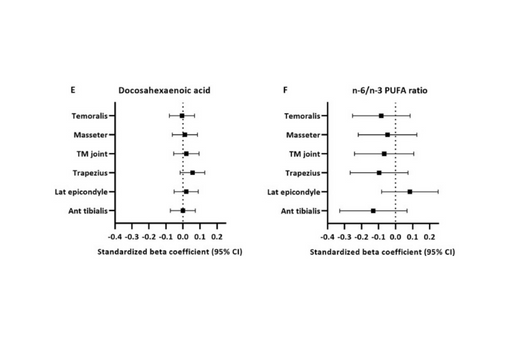Circulating polyunsaturated fatty acids, pressure pain thresholds, and nociplastic pain conditions
Abstract
Objective
Polyunsaturated fatty acids (PUFAs) play a role in pain regulation. This study sought to determine whether free PUFAs found in red blood cells also play a role in nociceptive processing. We examined associations between circulating PUFAs and nociceptive thresholds to noxious mechanical stimuli. We also determined whether nociceptive thresholds were associated with nociplastic pain conditions.
Methods
This cross-sectional study used stored red bloods cells and data from 605 adult participants in the OPPERA-2 study of chronic overlapping pain conditions. In OPPERA-2 adults completed quantitative sensory testing in which pressure algometry measured deep muscular tissue sensitivity at six anatomical sites. Standardized protocols classified adults for presence or absence of five nociplastic pain conditions: temporomandibular disorder, headache, low back pain, irritable bowel syndrome and fibromyalgia. Liquid chromatography tandem mass spectroscopy quantified erythrocyte PUFAs. We conducted three sets of analyses. First, a multivariable linear regression model assessed the association between n-6/n-3 PUFA ratio and the number of overlapping nociplastic pain conditions. Second, a series of 36 multivariable linear regression models assessed covariate-adjusted associations between PUFAs and nociceptive thresholds at each of six anatomical sites. Third, a series of 30 multivariable linear regression models assessed covariate-adjusted associations between nociceptive thresholds at six anatomical sites and each of five pain conditions.
Results
In multiple linear regression, each unit increase in n-6/n-3 PUFA ratio was associated with more pain conditions (β = 0.30, 95% confidence limits: 0.07, 0.53, p = 0.012). Omega-6 linoleic acid and arachidonic acid were negatively associated with lower nociceptive thresholds at three and at five, respectively, anatomical sites. In contrast, omega-3 alpha-linolenic acid, eicosapentaenoic acid, docosahexaenoic acid and the n-6/n-3 PUFA ratio were not associated with nociceptive thresholds at any site. Pain cases had significantly lower nociceptive thresholds than non-case controls at all anatomical sites.
Conclusion
A higher n-6/n-3 PUFA ratio was associated with more pain conditions. Omega-6 PUFAs may promote a generalized upregulation of nociceptive processing.
Citation
Sanders, A. E., Weatherspoon, E. D., Ehrmann, B. M., Soma, P. S., Shaikh, S. R., Preisser, J. S., Ohrbach, R., Fillingim, R. B., & Slade, G. D. (2022). Circulating polyunsaturated fatty acids, pressure pain thresholds, and nociplastic pain conditions. Prostaglandins, Leukotrienes and Essential Fatty Acids, 184, 102476. https://doi.org/10.1016/j.plefa.2022.102476


